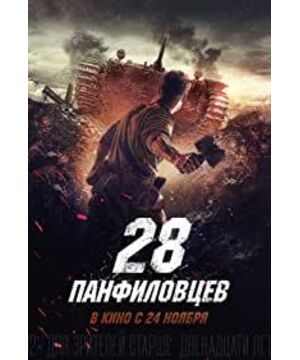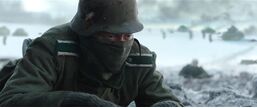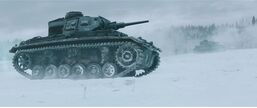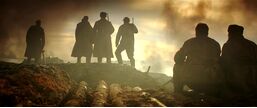Attached some information:
In January 1942, after the German army in Dubosekovo was wiped out, Krivitsky went to the local area on the instructions of Ortenberg to conduct a field trip to collect information to make their false reports appear to be More real, including the regiment commander Kaprov, regiment political commissar Akhmetzhan Muhamedyarov (Akhmetzhan Muhamedyarov) and the 4th company commander Pavel Gundilovich (Pavel Gundilovich) accompanied them. The local villagers took in the remains of 6 Soviet officers and soldiers, including Klochkov, the trainee instructor of the 4th Company, so he naturally became the leader of the 28 warriors. Tsky pinpointed the location of a mass grave. According to Krivitsky's request, Mehmet Yarov and Gunidilovich selected 28 names from the list of the 4th Company killed and missing, so that the "28 Panfilov Warriors" have a name, Strictly speaking. The field visit provided new material for Krivitsky's Jan. 22 essay, and gave the false heroic saga final shape. As for Klochkov's last words, Krivitsky admitted during his postwar investigation that they were his personal creation. Both Korodeev and Ortenberg stressed to the military judges that their motives were to boost the morale of front-line troops.
With the deepening of the investigation, Lieutenant General Afanasyev also found that in the "28 Warriors", in addition to Kozhubegnov and Dobrobabin, there were 4 people who were not killed in action, and 2 of them were seriously injured and sent to the hospital. In the rear hospital, 2 were captured by the Germans and survived the war. On May 10, 1948, Afanasyev submitted an investigation report to the Prosecutor General of the Soviet Union. In his report, he concluded that the "28 Panfilov Warriors" were completely non-existent and purely fabricated. Afanasyev's report was also sent to Stalin, Zhdanov and other senior leaders of the party and government for review. Obviously this is an extremely embarrassing fact, that a widely publicized hero model was fabricated, which is undoubtedly a serious scandal. For very natural reasons, the report was shelved from the public, and all counterfeiters were not held accountable.
In the early morning of November 16, German tank units carried out fire reconnaissance to the Soviet forward positions. According to Caprov's recollection, there were 10-12 tanks in front of the 2nd Battalion's position alone, but he did not know how many tanks were in front of the 4th Company's position. The result of the outpost battle was that the German army was in front of the 1075th regiment's position. Withdrew after losing 5-6 tanks. Soon, the German army entered the reserve and launched an all-out attack on the 1075th Regiment. After 40 to 50 minutes of fierce and brutal fighting, the Soviet defense line was broken through. Kaprov rushed to the front from the regiment headquarters, and personally gathered the surviving officers and soldiers and moved them to new positions. In this defensive battle, Captain Gunidilovich's 4th Company suffered the heaviest losses. Only 20 to 25 of the 140 people in the entire company survived. The other companies of the regiment suffered relatively light losses. The Soviets failed to hold the Dubosekovo area, which was occupied by the Germans and was not recaptured by the Soviets until December 20. According to the Soviet military report, the 1075th regiment destroyed a total of 9 German tanks on November 16, which was only half of the number of tanks destroyed by the "Panfilov 28 Warriors" in the report, and was still the result of the entire regiment.
From November 16th to 20th, the 316th Infantry Division and other Soviet units defending Volokolamsk were attacked by two German armored divisions and one infantry division, and gradually retreated to the outskirts of Moscow. Although the Germans eventually occupied Volokolamsk, the tenacious battle of the 316th Division caused great losses to the Germans, delayed the advance of the Germans, and consumed the German offensive. By the time they reached the spire, they were already dead. In the battle to defend Moscow, the 316th Division suffered huge sacrifices. The entire division suffered 9,920 casualties, of which 3,620 were killed and 6,300 were wounded. The tenacity of the 316th Division also impressed the Germans. General Erich Hoepner, commander of the 4th Panzer Group, gave a speech to Field Marshal Fedor von Bock, commander of Army Group Center. The telegram mentions the 316th Division: "This division is made up of barbarians, its soldiers do not fight according to any rules, they are extremely zealous, never surrender, and are not afraid of death."
The bloody fighting of the 316th Division was highly praised by the Soviet leadership. On November 17, Stalin approved the report of the People's Commissariat of Defense on the designation of the 316th Division "Guardian", which subsequently changed its designation to the 8th Guards Infantry Division. On November 18, the division commander, Major General Panfilov, was killed in battle, and he was posthumously awarded the title "Hero of the Soviet Union". On November 23, the People's Commissariat of Defense decided to name the 8th Guards Division after General Panfilov, one of only two divisions in Soviet history named after a commander, the other being Panfilov served in the 25th Infantry Division "Cabayev Division". Although the story of "28 Panfilov Warriors" is fictitious, the sacrificial spirit and outstanding military exploits of the officers and soldiers of Panfilov's division are undeniable, and they deserve the permanent memory of the Russians.
View more about Panfilov's 28 reviews








